Garden Glimpses: November Color
Better late than never, as they say. Autumn came in dribs and drabs this year, with the accent on the drab – tan, brown, and sepia tones dominated early fall, with bright, brilliant colors a rarity, but now that the ghosties and ghoulies have been (mostly) packed away, a few shots of bitter cold have turned what’s left of summer’s foliage into a stunning panoply of red, yellow and orange.
I’ve been traveling regularly up into the foothills of the Poconos of late, tending to my cousin’s cats while she is convalescing off-site from hip replacement surgery, and the half-hour drive has been considerably improved by the fabulous flora. Lots of late red oaks in that region, one of my favorite trees, along with a healthy smattering of yellow maples and rusty beech, and everyone seems to have a Burning Bush or two, now blazing at peak. It’s very wooded, rural terrain, windy backroads with picturesque views of stubbled fields, bold red barns, stone farmhouses and white church steeples that pierce the forested horizon. Norman Rockwell would have a field day.
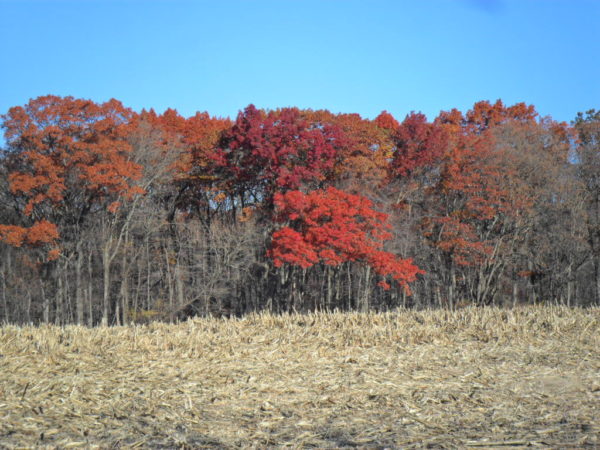
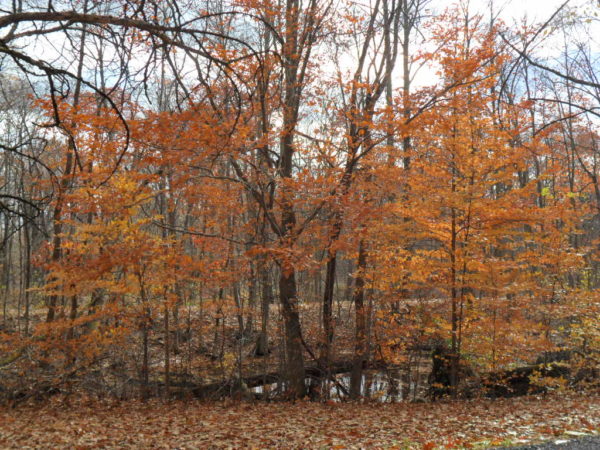
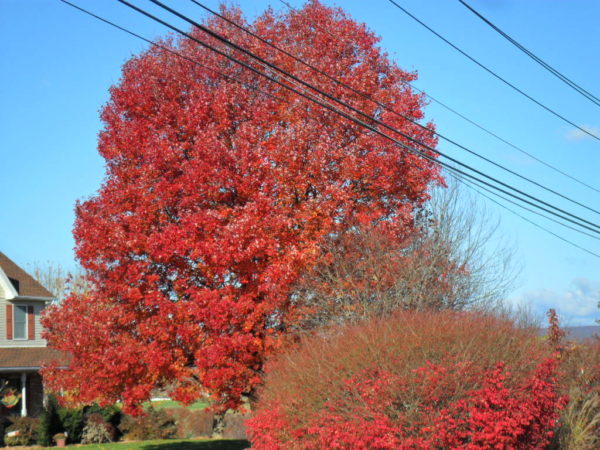
Last month we made the mandatory trek to Lancaster County for the pre-Halloween pumpkin-picking, scoring a bevy of captivating gourds, as always. I also found some wonderful replacements for my bunches of Indian corn (can we still call it that?), decimated by the squirrels last year, and an intriguing accent plant commonly known as “pumpkin on a stick”. Solanum integrifolium, to use its proper name, is actually a form of ornamental eggplant, and really does look like tiny burnt-orange pumpkins hanging all in a row on thick, sturdy stems studded with long thorns. Azure skies scuffed with streaky white clouds and a crisp cool breeze combined to make it an ideal day for ransacking stacks of pumpkins and gourds, searching for that flawless specimen to bring back for display or carving into Jack-o-lanterns. Although the archives are stuffed with such images, I can’t seem to resist snapping fresh shots of the piled provender by the roadside stands, always looking for that perfect composition.
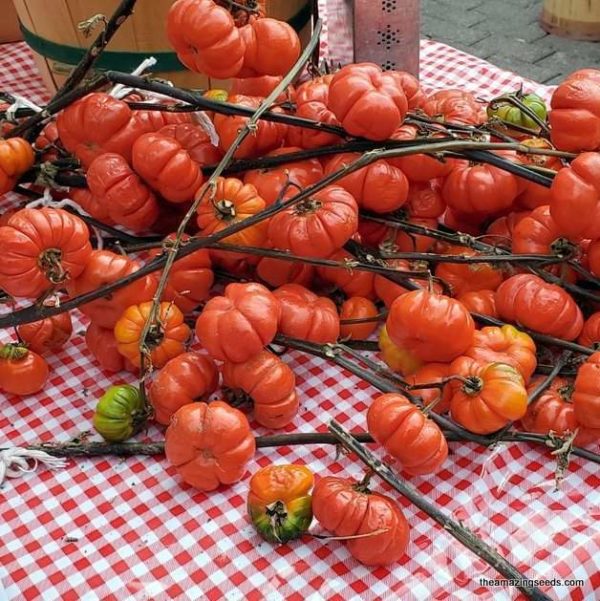
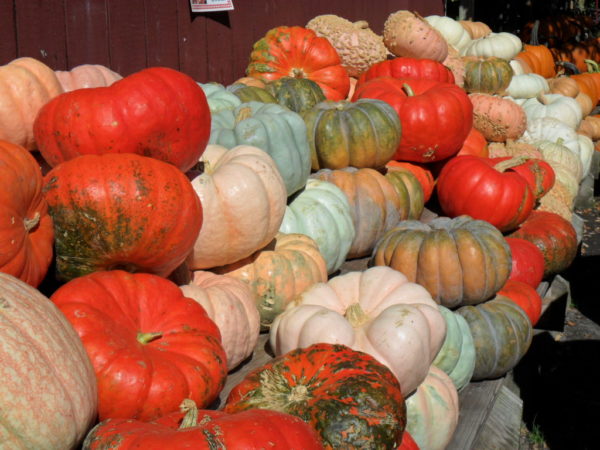

In the garden, as in the landscape at large, it’s been a very delayed autumn. We did get the late bloomers, pretty much on schedule, in mid-October. It was the first season for my helianthus “Autumn Gold” and the Montauk daisy, both of which glowed with light seemingly stolen from the waning sun. Autumn Gold is aptly named, with vibrant bursts of yellow daisy-like blossoms, punctuated with small brown centers; it did exceptionally well for its first year. Montauk daisy is the last to bloom, its bright white petals with large yellow centers blazing in the sun and shimmering in the dusky twilight.
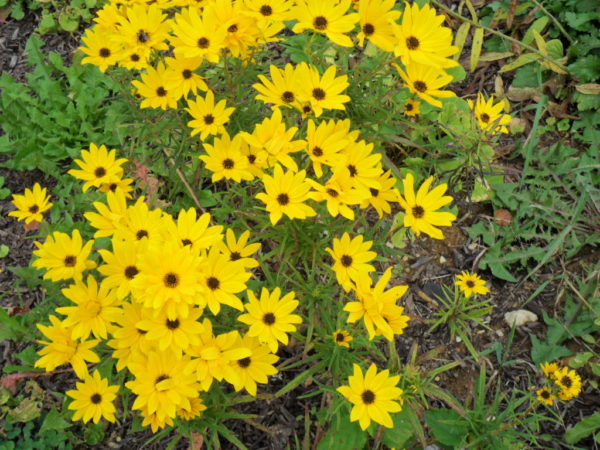

But it was the fall foliage color that I was anticipating most, and in general, I was pleased. When planning a garden of this size, it’s important to consider all four seasons, to have something of interest year-round. With colorful blooms decidedly on their way out by mid-autumn, leaf color can take up the slack for a few weeks, and berried shrubs add further focal points as fall deepens to winter.
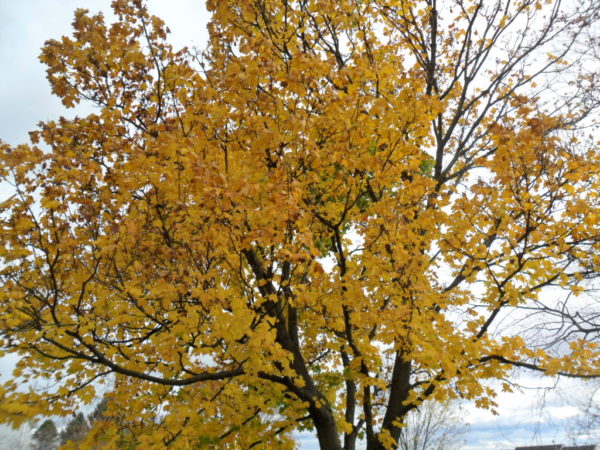
On that score, I’ve spent the last two years beefing up my fall color-makers. The property came with a large Chinese dogwood out front, which develops lovely mottled hues of red-burgundy and rusty orange, and a yellow-leafed Norway maple in the rear, bright as spun gold. The birches never really color well, they tend to brown and drop early, likely due to the ongoing low-level drought conditions (as well as a bit of recurring leaf miner damage). Other than those, and a few struggling chrysanthemums in the foundation plantings, there wasn’t much to offer for autumn interest.
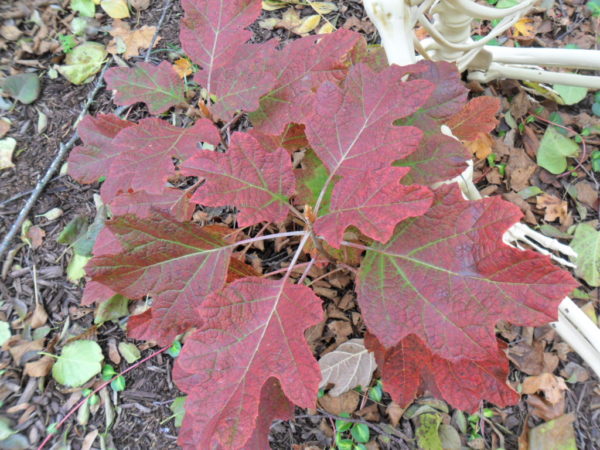
Enter the oakleaf hydrangeas. In time, these wonderful woody shrubs will grow into clumps as large as eight feet by eight feet, affording dramatic masses of color, but even as babies they brighten up the landscape considerably. Not only do they sport large white to cream to greenish white flowers in the summer, which fade to tan, but their autumn hues are standout lovely. Ranging in tones from burgundy to brick and brownish red, they provide islands of late color in an otherwise bleak vista.
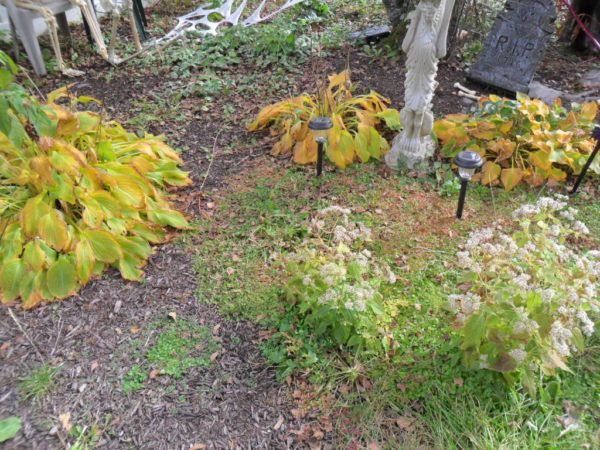
Another old friend lending a hand for fall interest is the humble hosta. I have more than a dozen varieties of these, typically variegated green-and-white or in lime to bluish tints (but with a few Plain Jane green ones thrown in the mix), and many turn vivid gold before fading to parchment, creating small mounds of pops of yellow color scattered across the garden.

If you’re looking for fall fruit and foliage, you can’t do much better than aronia, the native chokeberry. These come in red- and black-berried varieties, and really set the landscape ablaze. Red-fruited Brilliantissima lives up to its name, with glaring red leaves in late October and November, accompanied by attractive berries which the birds prize highly. Its black-fruited cousin Viking didn’t bloom or fruit for me in this first year, but came through with lovely mottled foliage in orange and amber. Although aronia tolerates shade, I suspect this Viking, directly under the maple, is getting too much of a good thing, and might have to be relocated to bloom, but I’ll give it another year to settle in and see how it does.
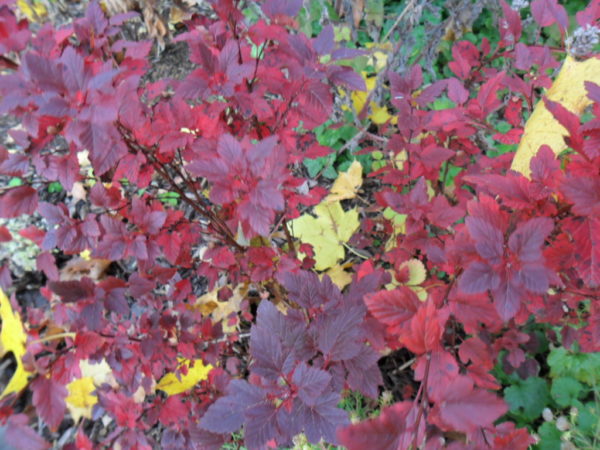
Physocarpus Sweet Cherry Tea is another newbie that has outperformed my expectations. Covered in medium pink blossoms in spring with some summer rebloom, physocarpus wows all season long with purplish-red foliage, but turns up the volume to 11 when autumn deepens, as the leaves become a positively incandescent burgundy-red.
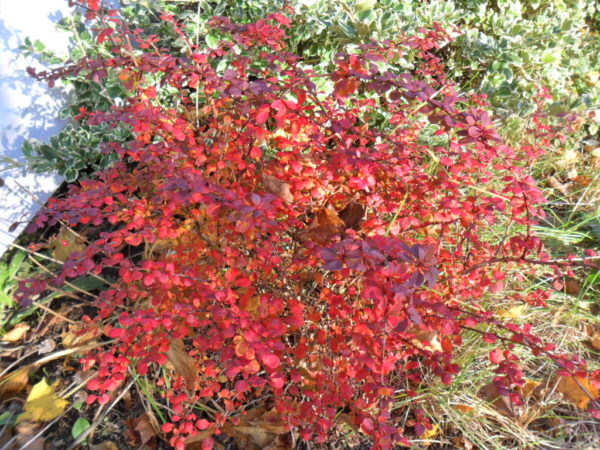
Barberry is a reliable, if ubiquitous, autumn favorite. The variety I have, Sunjoy Tangelo, purports to have red foliage all season long, but probably gets less sun than it wants in its location to retain that burst of color in its first spring growth. It makes up for this in autumn, however, by a show of brilliant reds and oranges, and a sprinkling of miniscule red berries to boot.
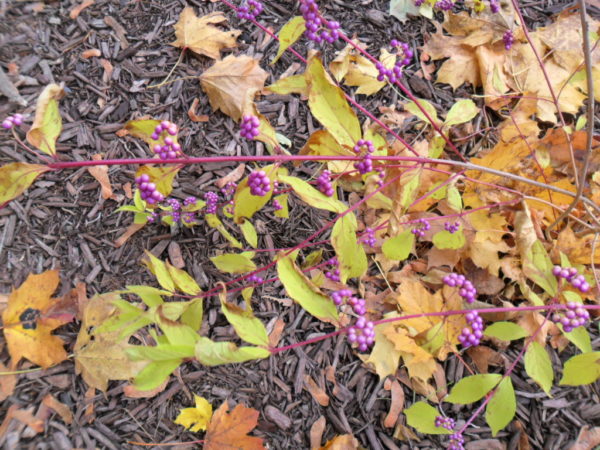
Callicarpa Americana, AKA “Beautyberry”, lends a truly unique berry color for fall – purple! The color is so bright, it doesn’t look real, one reason I resisted acquiring one for years. But I’m very glad I broke down and bought a specimen from my local perennial farm in their August clearance sale this year. The berries really pop with eye-catching color, grouped in clusters along gracefully sweeping elongated branches, and the foliage turns a charming medium yellow before dropping to reveal stark bunches of berries, perfect for winter arrangements.
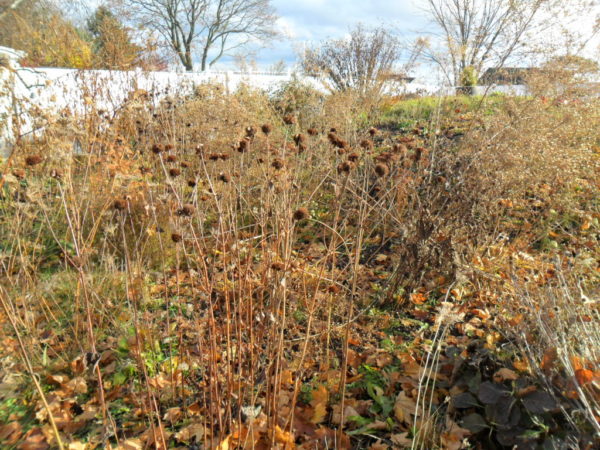
Small trees can supply color as well. I have to say, while I was pleased by the growth on the newly-planted cornus alternifolia (Pagoda Dogwood) in its first full year, the fall color was extremely disappointing, compared to when it was installed last autumn. Speckled red-to-yellow leaves, with purplish highlights, when these were barely more than twigs, promised a bonanza of color as they matured this year, but that potential was sadly unfulfilled. I suspect drought is once again the culprit; though I keep them watered, it’s not the same as a good soaking rain, and this year the leaves just browned and dropped.
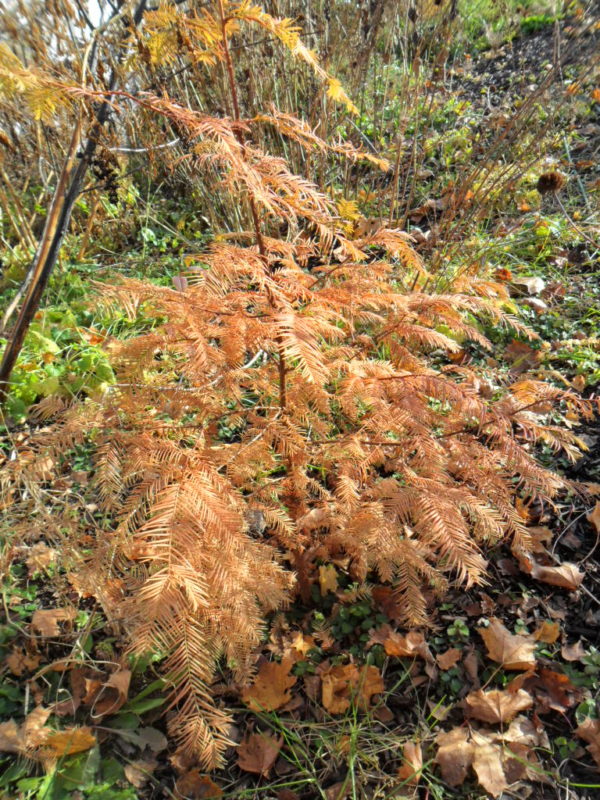
But the new Dawn Redwood, which grew by leaps and bounds since its June planting, made a brave show in cinnamon when its deciduous needles changed color, seemingly overnight, before dropping. When it matures, this will be a lovely specimen and make a dramatic statement in the garden.
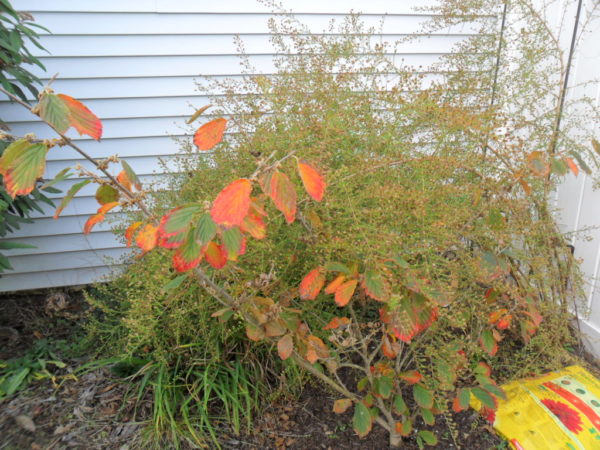
Witch hazel is another small tree which offers all-season interest. Its sparkling yellow-orange blossoms are among the first to open in the spring, sometimes as early as February. Thickly clustered on bare branches, these harbingers of better days to come are a welcome sight and an antidote to the winter blues. In summer, the foliage is a unique reminder of the differentiation in nature, with their saw-toothed edges on deeply furrowed leaves. When autumn comes, these transform into a kaleidoscope of orange, rust and yellow tones, glowing in the landscape.
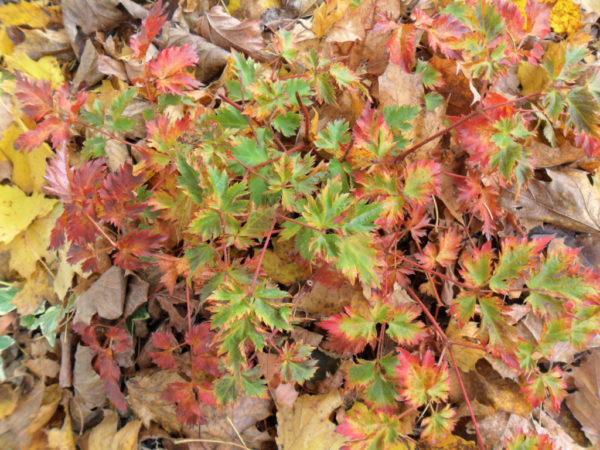
Smaller perennials can provide surprisingly bold colors as well. Astilbe Delft Lace, gorgeous in late spring with its many-branched flowers covered in fluffy pink blossoms, sports red-edged foliage year-round, but really flares in October as these margins fairly glow, and the green centers turn golden.
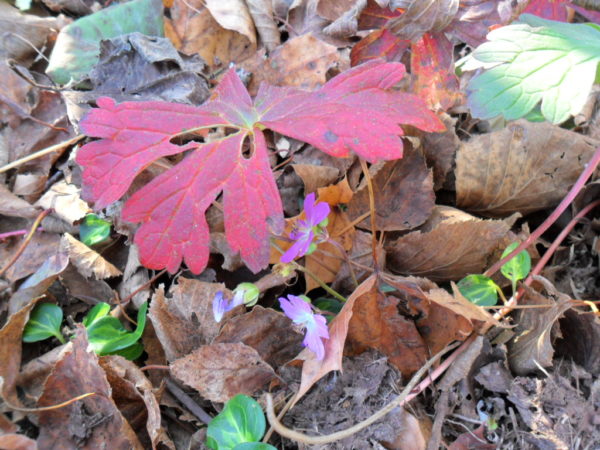
Native hardy geranium is another source of unexpected fall color. I put in two large stands of these blue-flowered beauties in the spring, but due to their small size they never bloomed this year. Until now! Two or three have sent up tiny flower stems with a pair or two of buds, which opened just in time for the lapis lazuli blossoms to contrast vividly with their autumn foliage, which colors from emerald green to deep burgundy-red in early October.
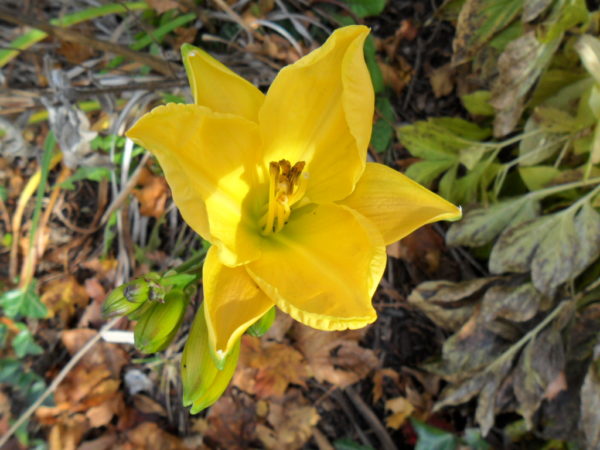
But perhaps the most unexpected source of color this fall, albeit limited, was a daylily! While many of my new daylilies are marketed as “reblooming”, in practice, for me, these are as rare as unicorns, and perhaps just as mythic. “Buttered Popcorn”, however, at least tries. Last year it sent up a pair of budded scapes in late September, but these froze out at Halloween when an unexpected plunge in temperatures sent the thermometer well south of freezing. This year, we were luckier. Four scapes, all heavily budded, and though so far only one bloom has opened, they have weathered some pretty bitter cold. But here’s the thing – these are “day”lilies, right? Supposed to bloom for a day, and done? Well, the cooler temps and low light seem to have conspired to counteract that trait. The vivid yellow blossom currently brightening the western bed has been open for a full week! I’ve never seen anything like it.
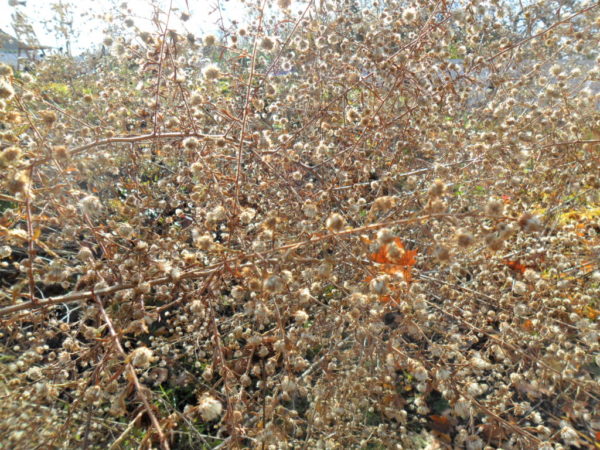
Winterberry and holly are warming up in the bullpen for their winter show, when they will dominate the garden with evergreens such as boxwood, chamaecyparis, Mugo pine and leatherleaf verbena. In the meantime there’s still a lot of structural interest from burnt-out asters and echinacea, standing starkly skeletal with fluffy clusters of blossom gone to seed or compact floral cores like so many brown pinecones, and pokeberry retains its desiccated purple-black fruits on withered magenta-rust stems. There is beauty of a kind there, for those who can see it, as the wheel of the year turns on and on endlessly.
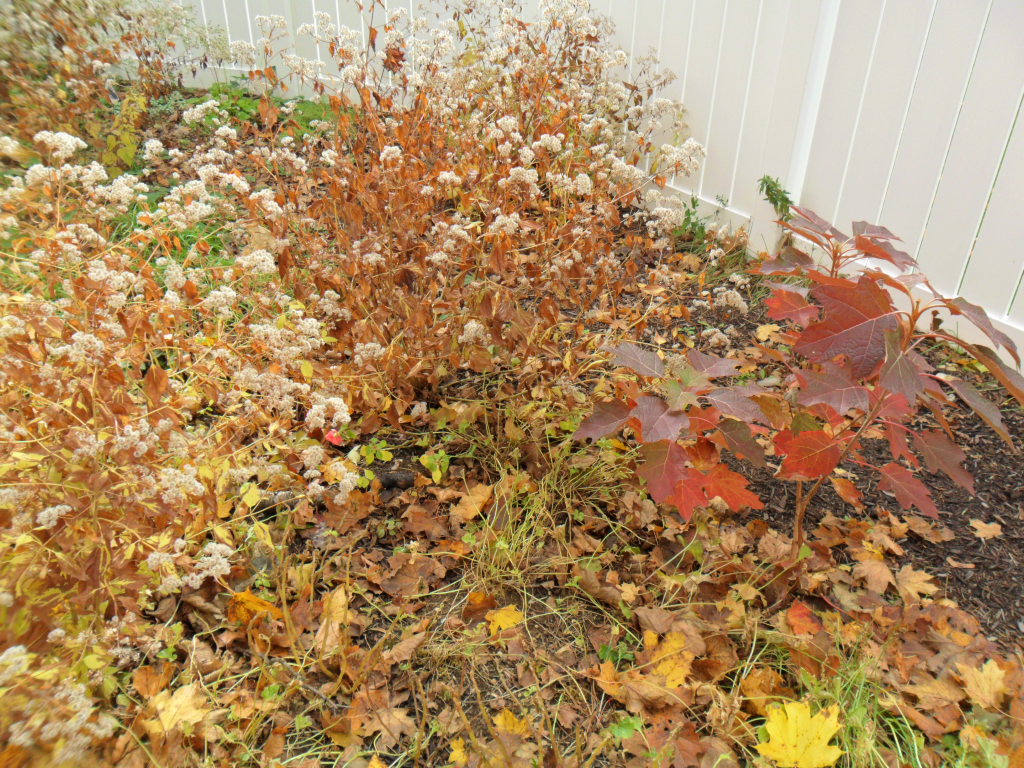

3 comments, add yours.
Vivah Aurora
LOVE IT! Love it! love it….
Laurien
So kind of you to take care of your cousin’s cats. I enjoyed seeing photos of plants I’ve never come across, like pumpkin on a stick and the lovely Dawn Redwood and Sweet Cherry Tea. How wonderful that you got some late blooms from your day lily and native geranium. I doubt I’ll ever see that here at 54° of latitude, although with climate change, who knows. I was surprised to see a few tiny violas still blooming in my garden the other day. Thanks for this post, Alex!
Susan
Just gorgeous, Alex!